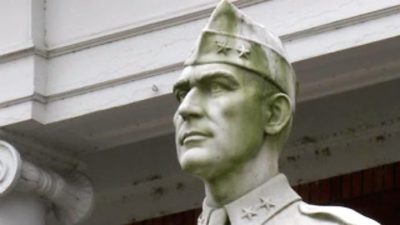Vandals in Dunn, North Carolina, last week doused the marble statue of Gen. Lee with a flammable liquid and set it on fire. But if they think they targeted Confederate Gen. Robert E. Lee, they got the wrong Lee, officials said.
The statue stands outside the Maj. Gen. William C. Lee Airborne Museum, which posted photos of the damage to Facebook, writing that “some jerk punk” had caused the blaze.
“The local fire department put out the flames but the damage is done. It scorched the statue mostly on the left side,” the post added.
The town of Dunn, which is 40 miles south of the capital Raleigh, was the birthplace of World War II hero William C. Lee, and the museum sits in the home the general and his wife owned. Lee, commanding officer of the legendary 101st Airborne Division, died in 1948.
Mark Johnson, the museum’s curator, told CNN affiliate WNCN that the vandals apparently made a mistake. “This is not a Civil War museum and this is not Robert E. Lee,” he said. “This is General William C. Lee from United States Army Airborne from World War II, so I was hurt and surprised that somebody would actually do this.”
The defacement last week comes after much debate in recent years about the proper place of Confederate war memorials and statues today. Significant amounts of ire have been pointed at a Gen. Lee who lived a century earlier.
Following a racially motivated shooting at a Charleston church in 2015 and riots in Charlottesville in 2017, local leaders in many states made decisions to remove or relocate Confederate statues.
In the wake of that violence, Confederate monuments across the country, including some depicting Gen. Robert E. Lee, have been vandalized.
Last August, vandals spray-painted a Lee statue in Richmond, Virginia and toppled a Confederate statue on the campus of the University of North Carolina. And earlier this week, vandals spray painted the Lee statue in Charlottesville, according to WDBJ.
William C. Lee won glory in a different war on a different continent during a different century.
Following World War I, Lee served as a peacetime military observer in Germany, where he saw first-hand how Hitler’s army was pioneering the use of airborne troops, according to the museum.
Lee was invited to the White House to brief Roosevelt, who ordered that Lee begin planning and training US troops to jump from planes with parachutes just as he’d seen German troops doing years earlier.
Lee rose to the rank of two-star general, leading what became the Army’s 101st Airborne. In his first address to his troops, he told them the division had no history, but it had a “rendezvous with destiny.”




